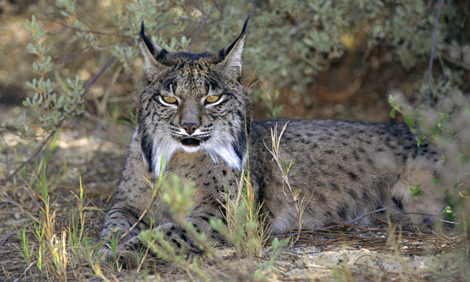


Related to the American bobcat, Iberian lynxes grow to be about three feet long. They have spotted coats of gray or brownish yellow fur, tufted ears, beards, and black rims around their eyes.
A wildcat known as the Iberian lynx once lived all over the Iberian Peninsula in southwestern Europe. The peninsula is mostly made up of the countries of Spain and Portugal. Over time, the Iberian lynx population began to decline. Many of the areas where they lived were destroyed by land development. Also, the kind of rabbit that the Iberian lynx depended on for food was dying out from disease.
In 2005, when the lynx population dropped to about 150, scientists working for an organization called Lynx Life decided to step in to try to save the cats from extinction. The scientists placed some lynxes in captivity. They hoped that the captured lynxes would breed, or have babies. The plan worked, and now about 100 Iberian lynxes live in captivity in Spain.
The scientists at Lynx Life are now starting to release the captive Iberian lynxes into the wild. They have selected a suitable area in which to release the lynxes. The area has lots of hills and shade for the cats to rest. There are also plenty of the rabbits for them to eat.
Before the lynxes were released, veterinarians made sure that they were in good health. The cats were also fitted with radio collars that allow Lynx Life to track them. The lynxes were a little confused at first to be back in the wild, but now they are exploring their new surroundings. If they do well, more Iberian lynxes will be released into areas across Spain and Portugal. Because of the work of Lynx Life and other scientists working to improve the lynx’s habitat, there are now about 300 Iberian lynxes living in the wild.
Image credit: ©Jose B. Ruiz/naturepl.com
Related Link
- Iberian Lynx – Photo Gallery
View striking photographs of the Iberian lynx in its natural habitat.


























